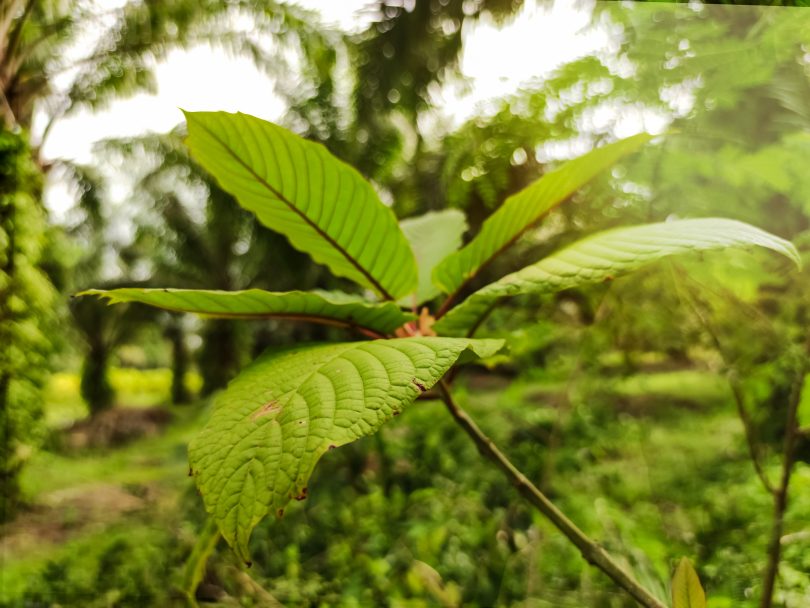Kratom (Mitragyna speciosa) is a flowering evergreen tree related to the coffee plant. It is indigenous to Southeast Asia but has been gaining popularity in western culture for its stimulating and pain-relieving effects. Kratom is used both recreationally and therapeutically, and just like cannabis, it’s incredibly controversial.
For quite some time now, the US Drug Enforcement Agency has been trying to add kratom to the Schedule I list of controlled substances. The available government information, plus a handful of misguided university studies, peg kratom as a “dangerous” plant with no known medical benefits. However, as a lifelong cannabis user, and someone who has watched weed transform from illegitimate and “dangerous” to a trending wellness product, I can say with certainty that we’re not getting the full story about kratom either.
When it comes to firsthand accounts from others, as well as my own personal experiences with the plant, and the hundreds of reports I’ve read online – everything indicates that kratom has therapeutic benefits that are worth investigating. As a matter of fact, the most common concern among consumers had nothing to do with the plant itself, but rather what will happen to them when they no longer have access to kratom products.
Kratom is made up of dozen of alkaloids, compounds which are known to hold medicinal value and have been studied independently for decades. Quite a few independent studies have noted the pharmaceutical potential of Kratom.
That’s not to say there are no risks. But, as is the case with any consumable product, some people may experience unexpected, adverse effects while the overwhelming majority do not. For the most part, people largely support the use of kratom and feel it’s vital to their quality of life – and when people talk, I think it’s important for us to listen.
Have you heard about DELTA-8 THC?
Unlike regular THC this lite-form is legal to order online, comes in Vapes, Gummies, Flowers, Dabs or Tinctures and has many medical benefits!
SUBSCRIBE below to the DELTA 8 WEEKLY newsletter:
The chemistry behind the plant
Although scientific literature on Kratom is scarce, it’s been around for a while and has piqued the interest of a few select researchers from around the world. What we do know that a total of 26 alkaloids have been isolated from kratom, and many of these compounds have been studied individually.
Alkaloids are a class of basic, naturally occurring organic compounds that contain at least one nitrogen atom. They are produced by a large variety of organisms including bacteria, fungi, plants, and animals and can be purified from crude extracts of these organisms by acid-base extraction, or solvent extractions followed by silica-gel column chromatography. Alkaloids have a wide range of pharmacological activities and a lot of research to back this up.
The most abundant alkaloid in Kratom is mitragynine, and for decades it was also believed to be the most potent. Then in 2002, a group of Japanese researchers found a variant called 7-hydronitragynine was discovered. This minor compound is extremely potent, more powerful than morphine, and despite being found only in trace amounts, it’s responsible for most of kratom’s pain-fighting properties. Further research has determined that both alkaloids act as partial opioid receptor agonists by activating the supraspinal mu- and delta- opioid receptors.
Kratom’s many chemical compounds
The alkaloid structure of kratom bares many similarities to those of other psychedelic drugs like LSD and psilocybin, but no mind-altering effects of that nature have even been reported after kratom use. Rather, kratom can be energizing and increase focus at low doses, and act as a depressant at higher doses. Regardless of the amount ingested, a certain level of pain relief can also be expected, thanks to kratom’s many alkaloid compounds.
Researchers have been able to isolate the following 26 alkaloids from kratom: Ajmalicin, 7-acetoxymitragynine, Corynantheidin, Corynoxein, Corinoxin, 3-Dehydromitragynin, (-)-Epicatechin, 3-Isocorynantheidin, 3-Isopaynanthein, Isomitraphyllin, Isospeciofolin, Isospecionoxein, Mitraciliatin, Mitrafolin, Mitragynalin , Mitraphylin, Mitraspecin, Mitraversin, Paynanthein, Speciociliatin, Speciofolin, Speciogynin, Specionoxein, Speciogynin, Speciofolin, and Stipulatin.
In total, kratom actually contains over 40 chemical compounds, but we’ll narrow it down to the three most important ones, 7-Hydroxymitragynine, Mitragynine and (-)-Epicatechin.
7-HYDROXYMITRAGYNINE
7-Hydroxymitragynine is technically a minor compound in kratom, but it’s by far the most potent, making it the main active ingredient in kratom powders and other products. This alkaloid has opioid agonistic activity and interacts with the three major opioid sites Kappa, Delta and Mu.
MITRAGYNINE
Mitragynine is an indole alkaloid that was isolated for the first time by D. Hooper in 1907. It’s the most abundant compound in kratom, and until 2002 was believed to be the most potent, although the latter turned out to not be the case. Small doses bind to the Delta receptors and act as a stimulant, while larger doses bind to the Mu receptors and have sedative effects.
(-)-EPICATECHIN
Epicatechin is a versatile flavanol that has anti-inflammatory effects and can help protect against free radicals. Epicatechin is one of the most abundant flavonoids present in different fruits such as apples, blackberries, broad beans, cherries, grapes, pears, raspberries, cocoa, and tea leaves.
History of kratom use
Kratom use spans back centuries and it’s hard to argue with a plant that has existed around humans for so long and has so many people and from different regions and cultures advocating for it.
As with most of the existing natural and holistic remedies, kratom use can be traced back to traditional Eastern medicine. Historically, in regions such as the Philippines and New Guinea, the chopped leaves were chewed or brewed into tea by local manual laborers who needed to stave fatigue and improve productivity at work. Additionally, various kratom preparations have been used during social and religious ceremonies and to treat numerous different medical conditions.
In Western literature, Kratom was first noted in the early 19th century but Dutch botanist Willem Korthals, who worked for the East India Company, an English company formed for to exploit trade options between the Middle East, Southeast Asia, and India. Researcher E. M. Holmes also referred to Kratom’s use as an opium substitute, identifying it specifically as Mitragyna speciosa in 1895.
Medical benefits
Again, official studies on kratom are lacking, but a recent survey of more than 2,700 self-reported users conducted by Johns Hopkins University found that a large majority of people are using this plant to alleviate pain. They also concluded that kratom “likely has a lower rate of harm and abuse” than prescription opioids, which are responsible for almost 50,000 deaths in the United States every year.
In a report on the findings, published in the Feb. 3 issue of Drug and Alcohol Dependence, the researchers caution that “ while self-reporting surveys aren’t always entirely reliable, they confirmed that kratom is not regulated or approved by the U.S. Food and Drug Administration (FDA), and that scientific studies have not been done to formally establish safety and benefits.”
According to American Kratom Association (AKA), a consumer advocacy group, an estimated 10 to 16 million people in the U.S. are using kratom regularly. Kratom is full of alkaloids, which are present in many aspects of human life, including much of what we consume. Alkaloids have showed anti-inflammatory, anticancer, analgesics, local anesthetic and pain relief, neuropharmacologic, antimicrobial, antifungal, and many other activities
Benefits of kratom use include but are not limited to: elevated mood, increased energy, healthy and restful sleep, boosted energy, muscle relaxation, natural aphrodisiac, eliminate social anxiety, pain relief, and it can be used to help minimize the symptoms of withdrawal from illicit drugs.
Risks and adverse reactions
The jury is still out on what exactly the risks of kratom are, and whether they outweigh the benefits or not. Clueless researchers who have no firsthand experience with the plant say “yes” the risks are far too great, whereas anecdotes from people who have been using kratom regularly for years say “no” it’s totally safe and beneficial for overall wellness and quality of life.
That said, some people actually do have negative reactions to kratom such as high blood pressure and seizures. I feel like it’s important to emphasize that this can happen with anything though, just like people can have allergic or other physical reactions to perfectly healthy foods and natural compounds.
Data from the Poison Control states that, between 2011 and 2017, call centers in the United States received about 1,800 reports that involved kratom use – although many of them were more a combination of paranoia and hypochondria rather then any real physical symptoms. Additional side effects can include dry mouth, dizziness, drowsiness, hallucinations, shortness of breath, and chills.
In the same vein as other pain medications, problems with negative side effects typically occur when kratom is used in unusually high doses or for a prolonged period of time. From what I’ve read, all of the negative experiences with kratom involved the use of highly concentrated extracts, not the bulk powered or teas that most people are using.
Final thoughts
So, now that you’re more informed on the inner workings of this natural pain reliever, you’re probably wondering if kratom is right for you. Ultimately, that’s up to you to decide, but it’s certainly a sought-after, natural pain-reliever for anyone who doesn’t have a medical condition that would prevent them from using kratom.
What are your experiences with the plant? What are your favorite kratom products? If you have an opinion on the matter, we would love to hear more from you! Drop us a line in the comment section below and don’t forget to subscribe to the CBD Flowers Weekly Newsletter for more information on flowers and exclusive deals on flowers and other products.







